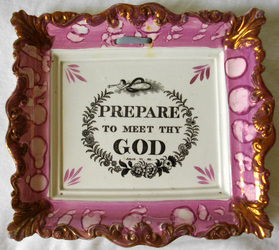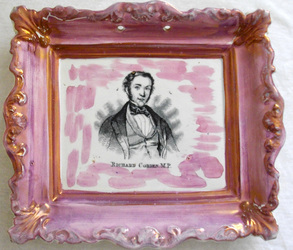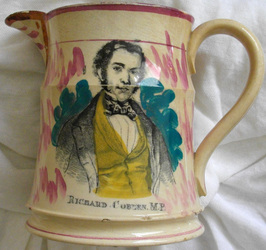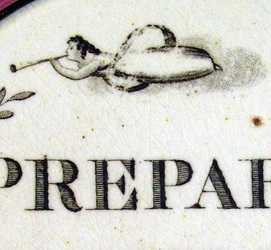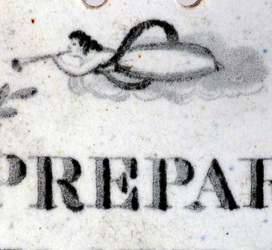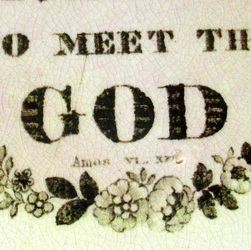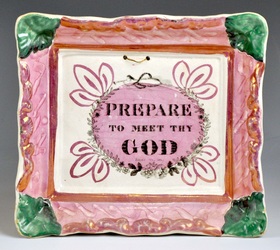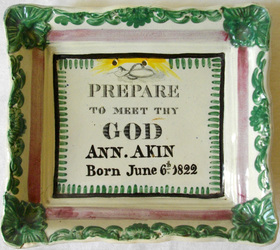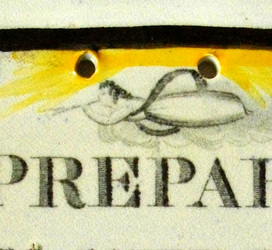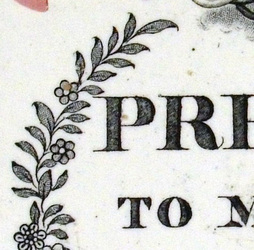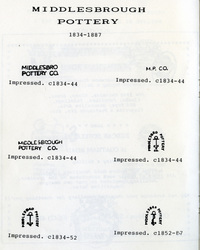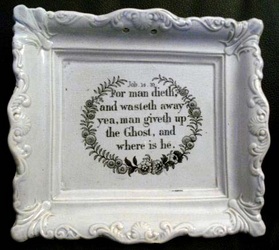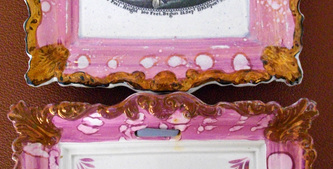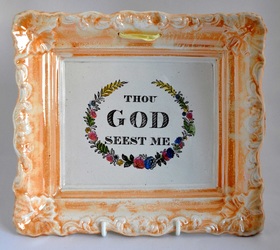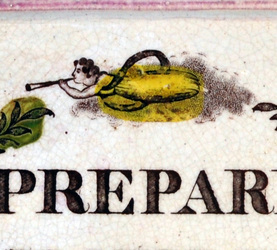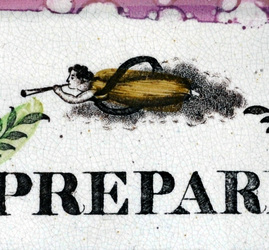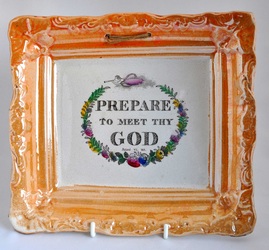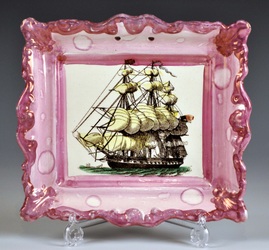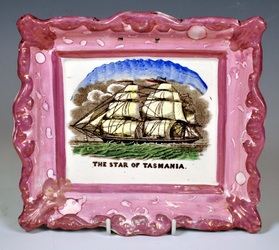|
5/27/2011 0 Comments John Carr and Richard CobdenUpdate, February 2023... I don't generally update my blog posts retrospectively, and my thoughts have moved on considerably in the last 12 years. Please see here, for my latest attribution of the Richard Cobden transfer. Ian Holmes, the owner of the pink plaque below, which appears in my May 23 posting, has taken another look at it. And guess what? It too has a John Carr & Sons impressed mark. So it isn't Middlesbrough after all. Ian suggests that the white plaque, which has a blurred transfer, was a factory second, and therefore not considered worth decorating with lustre. This accords with one or two of my all-white plaques, which have obvious manufacturing flaws. So what of the 'For man dieth' plaque below? It is of an identical form, with a transfer clearly from the same set of plates, but has a mark that appears on items of Middlesbrough pottery. The lustre is much more purple, but interestingly has worn in the same way. Below right is an unmarked 'Prepare' plaque from the same plate as those above, but with a purple border. There are at least two possibilities. Firstly, that these plaques were originally made in Middlesbrough, and then production moved to John Carr's pottery in North Shields. And secondly, that these plaques were all made by John Carr, and that the 'London' mark above was used by several potteries to designate items for a particular London distributor. The first plaque below has a transfer from the same plate. As discussed in my May 23 posting, it is of a larger size (21.9 x 24.0 cm). It is also much better quality than the plaques above, and certainly pre-dates them (this is evidenced by additional spots and scratches, acquired over time, which appear on the Carr transfers, but not on this earlier imprint). I think this plaque is c1840s, and the Carr plaques are post 1861. If we could work out where the plaque below came from, then we might be a step closer to sorting things out. Interestingly, Richard Cobden appears on this larger plaque form (21.9 x 24.1 cm). So a likely date is 1846 when the corn laws were repealed. If we look at the plaque forms with Cobden, can they tell us where these larger plaques were produced? The first plaque below is the large plaque form we're trying to attribute. The second is of a form attributed to Scott of Southwick. The third and fourth are from an unknown pottery on a larger-than-average size plaque form (20.7 x 23.5 cm), but smaller than the first plaque. Confusion abounds. I would rather have believed they were from two different transfer plates, but they aren't. Transfer plates often contained several different transfers. They were printed onto tissue paper and the relevant bits cut out and applied to the pottery. In this case there are snippets of what appear to be the tips of leaves or petals left behind from other transfers surrounding Cobden on the transfer plate. In the second details of the first two plaques, note the curly mark to the top left. In the last three plaques, note the mark to the left of Cobden's left ear. So the only positive ID is for the Scott-attributed plaque, made in Sunderland. So not Middlesbrough, or North Shields (Carr). Ian Holmes has thrown one more item into the mix. A jug attributed to Carr. The jug has a verse on one side that also appears on Scott-attributed plaques (below right). The jug is crudely decorated and potted. Ian suggests that it might have been made in 1865 (which fits in with the Carr attribution) to commemorate Cobden's death. So we're really no closer to identifying the origin of the larger plaques. Though we've at least established another link between them and Carr. Could Carr have made them? My feeling is that Scott's small rectangular plaques, which are finest in decoration, were made first. Cobden's work as a peace campaigner caused him to quickly fall out of favour and he was ridiculed by the press (see http://en.wikipedia.org/wiki/Richard_Cobden). His crashing fall from public popularity would explain why Scott sold the transfer plate. Looking at the crude decoration of the last two plaques, which is similar to that on the jug, it is possible they were made in the 1860s by Carr. I'm still not sure that's true for the first, larger-sized plaque, which looks to be finer. And I don't think the larger plaques were made by Scott either. Scott's Soutwick Pottery bought up the common religious verse transfer plates with such zeal, that it is hard to imagine them selling on a whole set to Carr. The best I can say is that perhaps these larger plaques were produced a bit later than I'd first supposed.
All answers on the back of a postcard please.
0 Comments
Please read my previous three blog posts first (I've added a second postscript, regarding Ball's Deptford pottery, to my last posting). This is the last group of plaques with angels facing left. As with the Dixon version, the verse reference, which appears on the first four plaques below, is incorrectly transcribed as ''Amos VI .. XII .". However, unlike the Dixon version, there are two full stops after the numeral 'VI ..'. The transfers are easily distinguishable from those in my previous postings because the word 'GOD' is shaded horizontally. The first four plaques below look to share the same transfer plate. I guess they are in date order because the transfer deteriorates over time. The fifth plaque has a very similar transfer, but without the garland or verse reference. I thought at first that they might have been blanked off. But if you look at the position of the angel, relative to the lettering, it is clearly a different transfer. The circular plaque is very similar in shape, colour and size to the Kinloch and Wesley plaques I've attributed to a Staffordshire pottery. So could this transfer plate have originated outside of the North East? If so, how did it find its way up to Tyneside? The last four plaque forms are of a form (18.3cm x 20.7cm) that sometimes appears with Maling impressed marks, though never to my knowledge with these common verses. N.B. Moore & Co made similar plaques, with what I've elsewhere called 'scalloped' corners, but the Moore versions are larger (20.5cm x 23cm). So are these plaques Maling? I'm not so sure. There have to be at least two other Tyneside contenders. The first plaque below has identical decoration to a pictorial plaque, titled 'La Polka', with the printed mark 'B. & Co.'. Perhaps the initials stand for the Tyneside company Bell & Co. (Isaac Bell is the link between Middlesbrough and Tyneside mentioned in my last posting.) The decoration on the second plaque below is very similar to that on a 'Prepare' plaque in my collection (bottom centre). This transfer, with the all-seeing eye, appears on typical plaques from John Carr's pottery (bottom right). So perhaps the best we can do for now is to say that the above transfers are Tyneside (Newcastle) as opposed to Wearside (Sunderland). As often happens, hours of looking produce more questions than they do answers.
Here's another instalment of 'Prepare' plaques with the angel facing left. First is a Dixon plaque for comparison (read about the features of the Dixon transfer in my previous post). The three plaques beneath it all come from the same non-Dixon transfer plate. (Thanks to Ian Holmes for sending me the photos.) The obvious difference is that the word 'God' is diagonally shaded in the opposite direction. The leaves on the sprig are longer and curve out more than on the Dixon transfer. However, this second transfer has copied the Dixon mistranscription of the verse as 'Amos VI. XII.' (It should read 'Amos IV. XII.'.) The non-Dixon transfer has some easily identifiable flaws. There is a small dot just beneath the letter 'P' (click on the images to enlarge), which reproduces on all three plaques. The engraver appears to have slipped while drawing the serif on the first letter 'R', which lurches upwards. The last two plaques share some additional flaws (implying they were made later), e.g. a dot below the second letter 'P', a dot just above the gap between the letters 'O' and 'D', and a small dash inside the letter 'A'. The first impressed mark below is on the reverse of the all-white plaque above. The illustration of how a clear imprint might look is from R C Bell's book on Tyneside Pottery. Bell says it was used by John Carr & Sons from 1861 onwards. But the pink lustre plaques above are older than that. The style of this 'prepare' transfer, with elongated leaves, is very similar to the 'For man dieth' transfer on the plaque below in the York Museums' collection. It has an impressed mark (below right) with the Middlesbrough anchor and the word 'London'. Clarice Blakey, in Northern Ceramic Society newsletter 210, suggests that the London mark was used at Middlesbrough between 1834–52. N.B. 'London' marks appear on items made in the North East, presumably destined for a London distributer. (Click here to read more about the use of the London mark.) The scans below are from P.J. Duce's booklet "A Guide to Teesside Pottery Marks". Note the 'London' mark top right. So perhaps the earlier pink lustre plaques are Middlesbrough, and at some point the transfer plates moved to John Carr's pottery in North Shields. The plaque photos below might support that. The first three show that the longer verses ('Behold God' and 'For man dieth'), like that on the York Museums' plaque, appear on all of the plaque forms shown above. The first plaque form is distinctive because it is unusually large in size (see the image below it, provided by Ian Holmes, which shows its comparative size to a bridge plaque attributed to Scott). The final plaque has a typical Carr shape and transfer from the 1860s, and is again undecorated. Unfortunately, plaques with 'London' and 'John Carr & Sons' impressed marks are exceptionally rare. Louise Harrison at the Dorman Museum in Middlesbrough writes 'A private collector who has done a lot of research on Middlesbrough marks told me that the “London” mark was used on pots made at both the Middlesbrough Pottery and at a number of potteries on Tyneside. The link between all these potteries is a man named Isaac Bell, who was at Middlesbrough c1838-1840 and on Tyneside from 1842 to the mid 1860s.' John Carr & Sons was one of the Tyneside potteries that used a 'London' impressed mark. If the Middlesbrough impressed plaque was made before 1840, and the Carr impressed plaque after 1860, what happened in between? The Dorman Museum has no record of the Middlesbrough Pottery producing lustre items. And note, the London mark above in Duce's guide is only 'attributed' to Middlesbrough. So more research needs to be done to firm up the Middlesbrough attribution. If you can fill in any gaps, please get in touch. P.S.R C Bell in his book on Tyneside Pottery also identifies the London mark with anchor as belonging to Middlesbrough (see below). He suggests that although this mark might have been used by other potteries, that the number 18 is specific to Middlesbrough. I've reproduced the impressed mark on the Middlesbrough-attributed plaque beneath it, which clearly has a number 18. P.P.S.And where else would we expect the above 'Prepare' transfer plate to end up other than Ball's Deptford pottery? For a similar Ball's-attributed example see plate XVI, p30, Baker. Note the long serif on the 'R' and the dot under the 'P'.
Please read my previous blog post first. I've been thinking about the other Dixon transfers that appear on Scott plaques. As before, the first three rows below are Dixon. The fourth row is attributed to Scott, and the fifth to Moore & Co. There were a few holes in my series, so I've filled them with photos of Lord Lucan (also missing). I haven't examined them closely enough yet, to work out whether each column of plaques comes from the same plate, but it seems logical that they should be. Obvious as it now appears, I hadn't registered before that Dixon never made a 'Praise Ye/Yea the Lord' plaque. Or perhaps they did, but for some reason produced very few of them. (Perhaps Lord Lucan has one.) P.S.In case you're wondering what happened to Wesley and Clarke, Dixon's two other common religious transfers, remember that those transfer plates went to John Carr's Low Lights Pottery in North Shields, presumably in 1865 when the Garrison Pottery closed. See my previous blog posts on the Dixon Wesley and Dixon Clarke.
I'm now feeling strong enough to look again at the 'Prepare' transfers. This time with the angel facing left. The first three plaques below are from the Garrison Pottery, Sunderland. The first is unmarked and could have been made as early as c1830. The second has the Dixon, Phillips & Co anchor impressed mark, used c1834–c1850. The third plaque has the impressed mark 'Dixon Co', which appears to have been used from c1850–1865. The fourth and fifth plaques are of forms associated with Scott of Southwick. The final orange plaque is of a form attributed to Moore & Co. The exciting thing is that all of these plaques have transfers from the same copper plate. (Click on the images to enlarge.) So how can I be so sure? There is a small black dot to the lower right of the first leaf on the left sprig, hovering about 1cm above the first 'R' in prepare. This fault on the transfer plate reproduces every time a transfer is printed. The above photos offer a glimpse of the varied use of one transfer plate over nearly 50 years.
In 1865, when the Garrison Pottery closed, it looks as if Scott's Southwick Pottery bought the transfer plate. The penultimate plaque above emulates a form used by Galloway and Atkinson, who took over the Albion Pottery in 1864. So Scott recycled an old Dixon transfer, on a brand-new plaque form. It's not surprising that the transfer also appears on the orange Moore & Co plaque form. As shown in my last blog post, Scott transfers often appear on plaques from moulds associated with Moore. There are at least two other transfer plates with the angel facing left, which weren't used by either Dixon or Scott. I'll try to pick through their differences sometime soon. I couldn't resist posting these two columns of plaques. On the left are brown-bordered plaques attributed to Scott of Southwick. On the right are plaques with a distinctive dark pink inner border, associated with Moore & Co's neighbouring Wear Pottery. The Duke of Wellington (third plaque down) has a Moore & Co impressed mark. The subjects relate to the Crimean period (c1853–1856) and just after (the last ship, The Great Eastern, was launched in 1858). As far as I can tell, despite coming from different potteries, each pair is printed from the same transfer plate. So which set came first? Or were they both produced at the same time? Records show that Scott supplied Moore's Wear Pottery with earthenware, 'presumably plain for decoration' (Baker). But the above transfers are more usually associated with Scott than Moore. For the common ships, e.g. The Great Eastern Steamship or Victoria and Albert Yacht, I've perhaps seen as many as 15 Scott versions for every 1 Moore & Co. The transfers appear on other Scott items, e.g. bowls (see Baker page 51 for an example). I can't remember seeing them on Moore & Co jugs or bowls. We know that these transfers were used at least into the 1860s when orange lustre first appeared. On the left below is a shape of plaque associated with Scott, and on the right a plaque shape associated with Moore & Co. There is a third contender for decorating these plaques. Thanks to Norman Lowe for supplying photos of the blue rolling pin below. He wonders whether Moore and Scott sent their items to be decorated at the nearby Sheepfolds Warehouse, Monkwearmouth, operated by Thomas Snowball. Sheepfolds made their money decorating items of plain earthenware. Baker writes that they also had a sideline in decorating glass rolling pins and selling them cheaply to sailors. Take a look at the photos below. The transfers on the rolling pin also appear on Scott and Moore plaques. It is near impossible for me to prove from photos, however, that they came from the same transfer plates. But as always, this theory raises more questions than it answers. Many of the the transfers found on rolling pins never appear on plaques. I have a glass rolling pin with a ship from the series above, and the motto 'Love and be Happy'. I'd love to find this transfer on a plaque. (Also, if you have a pink Moore & Co La Bretagne, please speak up. I've never yet seen one.)
|
AuthorStephen Smith lives in London, and is always happy to hear from other collectors. If you have an interesting collection of plaques, and are based in the UK, he will photograph them for you. Free advice given regarding selling and dispersal of a collection, or to those wishing to start one. Just get in touch... Archives
February 2022
AcknowledgementsThis website is indebted to collectors, dealers and enthusiasts who have shared their knowledge or photos. In particular: Ian Holmes, Stephen Duckworth, Dick Henrywood, Norman Lowe, Keith Lovell, Donald H Ryan, Harold Crowder, Jack and Joyce Cockerill, Myrna Schkolne, Elinor Penna, Ian Sharp, Shauna Gregg at the Sunderland Museum, Keith Bell, Martyn Edgell, and Liz Denton.
|








